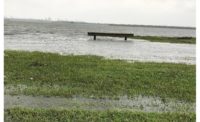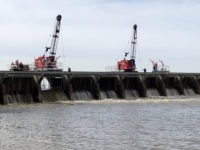Urban Flooding Called Nation’s Great ‘Hidden Challenge’ in New Report

This geocolor image from NOAA's GOES East satellite shows Florence's well-defined eye and outermost cloud bands approaching the Carolinas at 10:45 a.m. EST on Sept. 12.
Urban flooding is a “hidden” problem that is affecting large and small communities and will only get worse as the population grows, infrastructure ages, and extreme weather events become more common, according to a new study.
“We’re sort of like Paul Revere. Urban flooding is occurring, and it’s not just your town; it’s happening across the country,” says flood expert Gerry Galloway, a professor at the University of Maryland’s school of engineering and one of the authors of the study, “The Growing Threat of Urban Flooding: A National Challenge.”
Galloway teamed up with Sam Brody, director of Texas A&M’s Center for Texas Beaches and Shores, before Hurricane Harvey hit to study the issue of urban flooding. Harvey reaffirmed that flooding isn’t just limited to Federal Emergency Management Agency floodplain maps. In fact, the study found that at least 25% of flood claims nationwide made under the National Flood Insurance Program were from outside FEMA’s 100-year flood zone.
“If you are an inch outside the 100-year floodplain, you are treated like you are 1,000 miles out,” says Brody. “We need to get ahead of that same way of thinking.”
Flooding in urban areas is largely caused by the human-built environment, according to the report. The study found that no single federal agency is collecting data on urban flooding or taking responsibility for the phenomenon.
The team sent out requests to more than 1,000 stormwater and floodplain management officials. More than 700 people, representing 350 municipalities in 48 states, responded. Of those, 83% said they had experienced urban flooding; 46% said flooding occurred in several or most areas of their communities; and 85% said they experienced flooding outside the special flood hazard areas.
Inadequate drainage systems were identified by 70% of respondents as their community’s main problem. The flooding is often happening in low-income areas where residents can’t afford a day away from work, or to have their car flooded, Galloway says. “What is nuisance flooding to you might be a disaster to me,” he says. In some low-income areas, the main drainage system is still open ditches.
While the study recommends that solutions to urban flooding should be local, it also recommends that Congress and the federal administration work with states and municipalities to research and fund the problems and potential solutions.
Brody and Galloway have been contacted by several congressional staffers for briefings on the study. “We can’t change what we did in the past,” Brody says, “but we need to think about where we are putting that pavement.”




